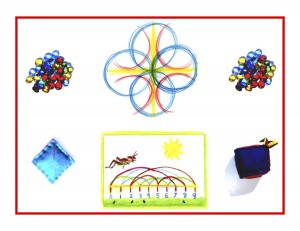Day 82
For one year, 365 days, this blog will address the Common Core Standards from the perspective of creating an alternate, ambient learning environment for math. Ambient is defined as “existing or present on all sides, an all-encompassing atmosphere.” And ambient music is defined as: “Quiet and relaxing with melodies that repeat many times.”
Why ambient? A math teaching style that’s whole and all encompassing, with themes that repeat many times through the years, is most likely to be effective and successful. Because the Common Core Grade 1 Math Standards address addition and subtraction exclusively, they will appear here later, in conjunction with the blocks that focus on the 4 processes. Earlier math blocks focus on meeting the numbers up close and personal through stories, movement, art, form drawing, and hands-on activities like making real numbers. The numbers should come together for calculation only after an in-depth introduction has established them as friendly and personable, so essential for circumventing math fears and phobias!
Yay! Back to math. That was quite a foray into CCSS Language Arts Standards. I will not be focusing on it to that extent with the other grades, but I wanted to point out that math does not exist in a vacuum. It works best when it’s cross-curricular in nature. Stories, art, and movement are such an essential part of a truly effective education, that needed space as well. I will touch on Language Arts Standards briefly in the other grades.
The second math block should focus on making real numbers. Why? Our base-ten, Arabic numeral system is simple to grasp; there are only 10 number forms to learn, 0-9. These numbers however, have little to no correlation to their visual appearance, as the Roman numerals do. Since they’re more abstract in that way, learning and writing them can be challenging. For this reason, sculpting or forming the numbers by hand can be very helpful, and there are many ways to do this.
Consider using a variety of tactile methods, insuring that a hands-on or more body based knowledge will always underscore abstract learning. The possibilities are endless, and remember that large and colorful is always best. Here are a few suggestions:
1) Use several different play clay recipes to sculpt the numbers.
2) Cut a set of numbers 0-9 out of colorful poster board, and tape them onto a wall.
3) Feature a different number at breakfast or lunch each day by cutting waffles or sandwiches into number shapes.
4) Wear the numbers, stenciled onto T-shirts or hats.
5) Use a bread recipe to make number-shaped loaves, or to make number pretzels.
Knowledge ensues in an environment dedicated to imaginative, creative knowing, where student and teacher alike surrender to the ensuing of that knowledge as a worthy goal. More real numbers tomorrow (a bit of a blend with Montessori), making sandpaper numbers. Tune in!












